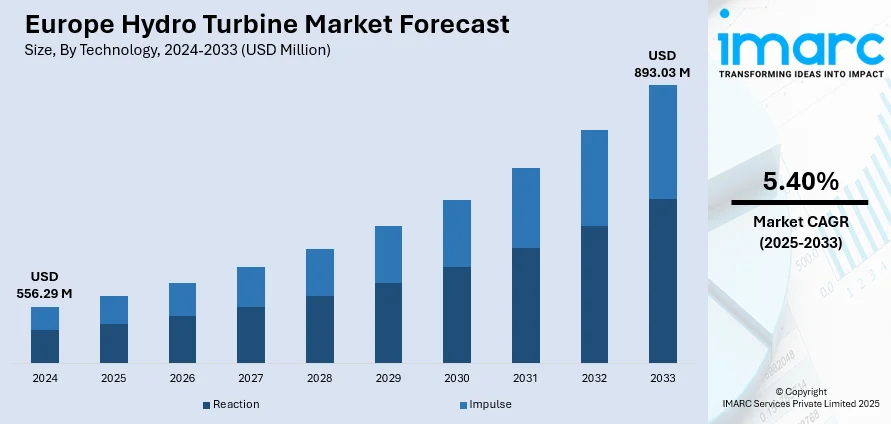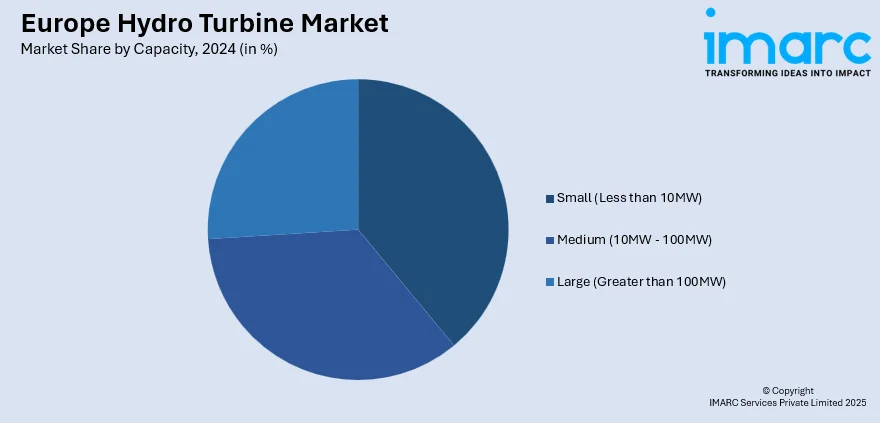
Europe Hydro Turbine Market Size, Share, Trends and Forecast by Technology, Capacity, and Country, 2025-2033
Europe Hydro Turbine Market Overview:
The Europe hydro turbine market size reached USD 556.29 Million in 2024. Looking forward, IMARC Group expects the market to reach USD 893.03 Million by 2033, exhibiting a growth rate (CAGR) of 5.40% during 2025-2033. The increasing investments in renewable energy, stringent environmental regulations promoting hydropower, advancements in turbine efficiency, government incentives, and the region’s push for energy security are fueling the market growth.
|
Report Attribute
|
Key Statistics
|
|---|---|
|
Base Year
|
2024
|
|
Forecast Years
|
2025-2033
|
|
Historical Years
|
2019-2024
|
| Market Size in 2024 | USD 556.29 Million |
| Market Forecast in 2033 | USD 893.03 Million |
| Market Growth Rate 2025-2033 | 5.40% |
Europe Hydro Turbine Market Trends:
Expansion of Pumped Storage Hydropower for Grid Stability
Pumped storage hydropower (PSH) is gaining traction in Europe as countries emphasize grid stability while boosting renewable energy integration. As wind and solar energy capacity grows, balancing supply and demand becomes critical. Pumped storage systems function as energy reservoirs, holding surplus power generated during peak output and releasing it when demand increases. Between 2023 and 2025, Europe planned to add around 4 GW of additional pumped storage capacity, including large projects in Switzerland, Austria, and Spain. The European Association for Storage of Energy (EASE) predicts that PSH will account for around 60% of the continent's energy storage capacity by 2025. Nant de Drance facility in Switzerland (900 MW) and the Gkioufa plant in Greece (700 MW) highlight ongoing investments in this sector. In line with this, governments and the EU are offering incentives and regulatory support, further impelling the market demand. For instance, the EU Green Deal and the Renewable Energy Directive target increased hydropower storage as a solution to intermittent energy generation. Additionally, innovations in variable-speed pump turbines are improving efficiency and responsiveness, further driving market growth.

Digitalization and AI-Driven Predictive Maintenance
The advent of digital technology, like artificial intelligence (AI) and the Internet of Things (IoT)-based predictive maintenance, is transforming the European hydro turbine sector. Traditional hydropower facilities are experiencing operational inefficiencies owing to aged infrastructure, necessitating innovative monitoring technologies to assure dependability and decrease downtime. From 2023 to 2025, the European hydro industry is expected to invest more than €2 billion in digitization initiatives, with Germany, France, and Norway leading the way. AI-powered condition monitoring systems may identify early indicators of mechanical breakdown, decreasing unexpected interruptions by up to 40 percent. IoT-enabled sensors and cloud-based analytics improve turbine performance, enhancing efficiency by 5–10%. A notable example is Statkraft's smart hydropower effort in Norway, which incorporates AI-driven data analysis to improve turbine longevity. Similarly, EDF (France) has deployed digital twin technology to simulate hydropower plant operations, improving asset management. Furthermore, regulatory bodies such as the EU Commission are pushing for digital transformation under initiatives like Horizon Europe, which allocates funding for AI-based energy innovations. The integration of digital solutions enhances predictive maintenance, minimizes operational costs, and ensures compliance with stringent environmental policies, fostering further hydro turbine adoption.
Europe Hydro Turbine Market Segmentation:
IMARC Group provides an analysis of the key trends in each segment of the market, along with forecasts at the region/country level for 2025-2033. Our report has categorized the market based on technology and capacity.
Technology Insights:
- Reaction
- Impulse
The report has provided a detailed breakup and analysis of the market based on the technology. This includes reaction and impulse.
Capacity Insights:

- Small (Less than 10MW)
- Medium (10MW - 100MW)
- Large (Greater than 100MW)
A detailed breakup and analysis of the market based on the capacity have also been provided in the report. This includes small (less than 10MW), medium (10MW - 100MW), and large (greater than 100MW).
Country Insights:
- Germany
- France
- United Kingdom
- Italy
- Spain
- Others
The report has also provided a comprehensive analysis of all the major regional markets, which include Germany, France, United Kingdom, Italy, Spain, and others.
Competitive Landscape:
The market research report has also provided a comprehensive analysis of the competitive landscape. Competitive analysis such as market structure, key player positioning, top winning strategies, competitive dashboard, and company evaluation quadrant has been covered in the report. Also, detailed profiles of all major companies have been provided.
Europe Hydro Turbine Market News:
- May 2024: SSE Renewables installed and commissioned the first of two new hydropower turbines at Scotland's Tummel Bridge Power Station. The £50 million upgrade will boost the station's production from 34MW to 40MW under ideal circumstances. The project will upgrade the site's original "Camel Back" twin-runner horizontal Francis turbines with modern runner technology, extending the power station's operational life by at least 40 years.
- January 2024: Swiss energy leaders revealed hydropower enhancements as part of the XFLEX HYDRO project, which aims to improve grid stability and promote the energy transition. Hybrid hydro turbine-battery systems, variable-speed turbines, and novel operational modes are among the innovations that will improve the dependability and value of Europe's power grid.
- January 2024: Statkraft, Europe's largest renewable energy provider, announced plans to invest up to six billion euros in upgrading existing Norwegian hydro and wind generating facilities, as well as building new onshore wind farms. The investment program will comprise hydroelectric power plant improvements and transformations, dam repair and modernization, as well as the renewal and building of current and new onshore wind farms.
Europe Hydro Turbine Market Report Coverage:
| Report Features | Details |
|---|---|
| Base Year of the Analysis | 2024 |
| Historical Period | 2019-2024 |
| Forecast Period | 2025-2033 |
| Units | Million USD |
| Scope of the Report |
Exploration of Historical Trends and Market Outlook, Industry Catalysts and Challenges, Segment-Wise Historical and Future Market Assessment:
|
| Technologies Covered | Reaction, Impulse |
| Capacities Covered | Small (Less than 10MW), Medium (10MW - 100MW), Large (Greater than 100MW) |
| Countries Covered | Germany, France, United Kingdom, Italy, Spain, Others |
| Customization Scope | 10% Free Customization |
| Post-Sale Analyst Support | 10-12 Weeks |
| Delivery Format | PDF and Excel through Email (We can also provide the editable version of the report in PPT/Word format on special request) |
Key Questions Answered in This Report:
- How has the Europe hydro turbine market performed so far and how will it perform in the coming years?
- What is the breakup of the Europe hydro turbine market on the basis of technology?
- What is the breakup of the Europe hydro turbine market on the basis of capacity?
- What are the various stages in the value chain of the Europe hydro turbine market?
- What are the key driving factors and challenges in the Europe hydro turbine?
- What is the structure of the Europe hydro turbine market and who are the key players?
- What is the degree of competition in the Europe hydro turbine market?
Key Benefits for Stakeholders:
- IMARC’s industry report offers a comprehensive quantitative analysis of various market segments, historical and current market trends, market forecasts, and dynamics of the Europe hydro turbine market from 2019-2033.
- The research report provides the latest information on the market drivers, challenges, and opportunities in the Europe hydro turbine market.
- Porter's five forces analysis assist stakeholders in assessing the impact of new entrants, competitive rivalry, supplier power, buyer power, and the threat of substitution. It helps stakeholders to analyze the level of competition within the Europe hydro turbine industry and its attractiveness.
- Competitive landscape allows stakeholders to understand their competitive environment and provides an insight into the current positions of key players in the market.
Need more help?
- Speak to our experienced analysts for insights on the current market scenarios.
- Include additional segments and countries to customize the report as per your requirement.
- Gain an unparalleled competitive advantage in your domain by understanding how to utilize the report and positively impacting your operations and revenue.
- For further assistance, please connect with our analysts.
 Request Customization
Request Customization
 Speak to an Analyst
Speak to an Analyst
 Request Brochure
Request Brochure
 Inquire Before Buying
Inquire Before Buying




.webp)




.webp)












